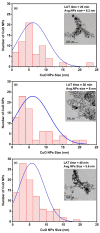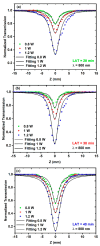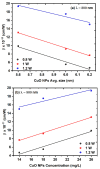Using Femtosecond Laser Light to Investigate the Concentration- and Size-Dependent Nonlinear Optical Properties of Laser-Ablated CuO Quantum Dots
- PMID: 39453010
- PMCID: PMC11509968
- DOI: 10.3390/nano14201674
Using Femtosecond Laser Light to Investigate the Concentration- and Size-Dependent Nonlinear Optical Properties of Laser-Ablated CuO Quantum Dots
Abstract
In this work, the nonlinear optical (NLO) properties of CuO nanoparticles (CuO NPs) were studied experimentally using the pulsed laser ablation (PLA) technique. A nanosecond Nd: YAG laser was employed as the ablation excitation source to create CuO NPs in distilled water. Various CuO NPs samples were prepared at ablation periods of 20, 30, and 40 min. Utilizing HR-TEM, the structure of the synthesized CuO NPs samples was verified. In addition, a UV-VIS spectrophotometer was used to investigate the linear features of the samples. The Z-scan technique was utilized to explore the NLO properties of CuO NPs samples, including the nonlinear absorption coefficient (β) and nonlinear refractive index (n2). An experimental study on the NLO features was conducted at a variety of excitation wavelengths (750-850 nm), average excitation powers (0.8-1.2 W), and CuO NPs sample concentrations and sizes. The reverse saturable absorption (RSA) behavior of all CuO NPs samples differed with the excitation wavelength and average excitation power. In addition, the CuO NPs samples demonstrated excellent optical limiters at various excitation wavelengths, with limitations dependent on the size and concentration of CuO NPs.
Keywords: copper nanoparticles; femtosecond laser; high repetition rate; nonlinear absorption; nonlinear optics; nonlinear refraction; optical limiter; quantum dots.
Conflict of interest statement
The authors declare no conflicts of interest.
Figures

















Similar articles
-
Using Femtosecond Laser Pulses to Explore the Nonlinear Optical Properties of Au NP Colloids That Were Synthesized by Laser Ablation.Nanomaterials (Basel). 2022 Aug 28;12(17):2980. doi: 10.3390/nano12172980. Nanomaterials (Basel). 2022. PMID: 36080017 Free PMC article.
-
Experimental Investigation of the Optical Nonlinearity of Laser-Ablated Titanium Dioxide Nanoparticles Using Femtosecond Laser Light Pulses.Nanomaterials (Basel). 2024 Dec 3;14(23):1940. doi: 10.3390/nano14231940. Nanomaterials (Basel). 2024. PMID: 39683328 Free PMC article.
-
Using Femtosecond Laser Pulses to Explore the Nonlinear Optical Properties of Ag/Au Alloy Nanoparticles Synthesized by Pulsed Laser Ablation in a Liquid.Nanomaterials (Basel). 2024 Jul 31;14(15):1290. doi: 10.3390/nano14151290. Nanomaterials (Basel). 2024. PMID: 39120395 Free PMC article.
-
Nonlinear Optical Properties of Zinc Oxide Nanoparticle Colloids Prepared by Pulsed Laser Ablation in Distilled Water.Nanomaterials (Basel). 2022 Nov 28;12(23):4220. doi: 10.3390/nano12234220. Nanomaterials (Basel). 2022. PMID: 36500847 Free PMC article.
-
Nonlinear photonics in glass systems doped with quantum dots and plasmonic nanoparticles.Nanoscale. 2025 May 29;17(21):13094-13120. doi: 10.1039/d5nr00669d. Nanoscale. 2025. PMID: 40356411 Review.
References
-
- Khan I., Saeed K., Khan I. Nanoparticles: Properties, applications, and toxicities. Arab. J. Chem. 2019;12:908–931. doi: 10.1016/j.arabjc.2017.05.011. - DOI
-
- Yaqoob A.A., Umar K., Ibrahim MN M. Silver nanoparticles: Various methods of synthesis, size affecting factors and their potential applications—A review. Appl. Nanosci. 2020;10:1369–1378. doi: 10.1007/s13204-020-01318-w. - DOI
-
- Giljohann D.A., Seferos D.S., Daniel W.L., Massich M.D., Patel P.C., Mirkin C.A. Spherical Nucleic Acids. Taylor & Francis Group; Abingdon, UK: 2020. Gold nanoparticles for biology and medicine; pp. 55–90.
LinkOut - more resources
Full Text Sources

